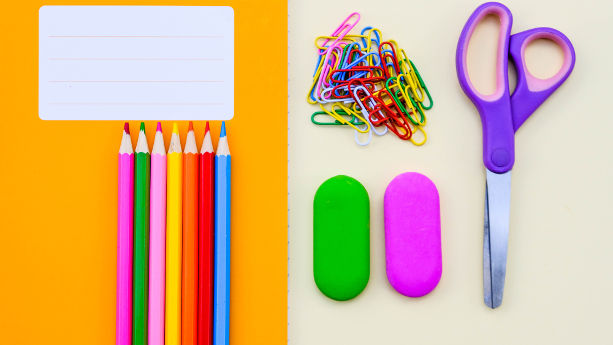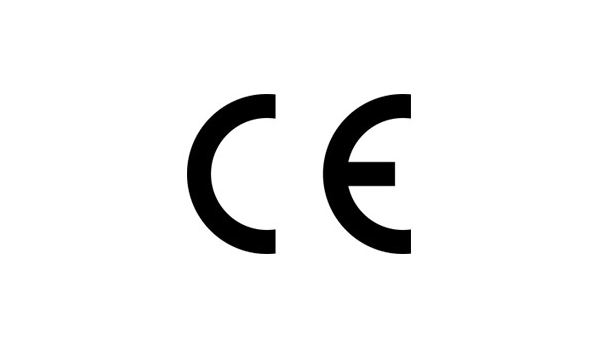
Children’s school supplies and stationary are subject to various safety standards, testing, and labeling requirements in the European Union. In this guide, we explain what importers and manufacturers must know about the Toy Safety Directive, CE marking, REACH, GPSD, EN standards – and other compliance requirements applicable to children’s school supplies and stationary.
Content Overview

FREE CONSULTATION CALL (US, EU & UK)
- Request a free 30-minute call with Ivan Malloci to learn how we can help you with:
- Find product requirements
- Certification and labeling
- Lab testing
Toy Safety Directive
The Toy Safety Directive lays down safety requirements for children products that are designed or intended for use in play by children under 14 years of age. As such, several categories of school supplies fall under the scope of the directive, including:
a. Coloring or painting articles provided that they are not intended for artistic use
b. Pencils or pens with an end that has the shape of an animal, clown, football player, or similar
c. Chalk
d. Finger paint
e. Toy sharpeners and erasers
For example, these colored STAEDTLER pencils are CE-marked and compliant with EN 71 standards.
Toy Safety Directive Requirements Summary
- EN 71-1: Mechanical and physical properties
- EN 71-3: Specification for migration of certain elements
- EN 71-4: Experimental sets for chemistry and related activities
- EN 71-7: Finger paints – Requirements and test methods
- Declaration of Conformity (DoC)
- Technical File
- User Instructions
- Test Reports
- CE Mark
EN 71-1: Mechanical and physical properties
EN 71-1 lays down requirements and testing methods for the mechanical and physical properties of toys, and it also specifies requirements for packaging, marking, and labeling.
For example, this standard lays down the safety requirements for school supplies that contain springs, edges, or small parts. School supplies with such physical properties should be tested to prevent unreasonable risk of injury to children.
EN 71-3: Specification for migration of certain elements
EN 71-3 aims at reducing children’s exposure to certain potentially toxic elements such as chemicals and heavy metals. Specifically, it sets out the migration limits for scrape-off, liquid, and dry materials used in products.
This standard applies to base material and coating used in some school supplies, for example, the surface coating of a pencil that is deemed to have play value.
EN 71-4: Experimental sets for chemistry and related activities
EN 71-4 specifies the requirements for substances used in experimental sets for chemistry and related activities. It covers hazardous chemical substances, product labeling, and also packaging requirements.
Here we list some examples of school supplies that might fall under the scope of EN 71-4:
- Crystal growing kit
- Kitchen science lab for kids
- Earth science kits
EN 71-7: Finger paints
EN 71-7 sets out the safety requirements for finger paints, which include substance limitations, additives requirements, and labeling guidelines. For example, finger paints must not be sweetened, flavored, or fragranced.
Here we list some finger paints that might fall under the scope of EN 71-7:
- Washable finger paints
- Tempera finger paints
Declaration of Conformity (DoC)
The Declaration of Conformity (DoC) is a self-issue document that is used to prove compliance with applicable CE directives, including school supplies that fall under the scope of the Toy Safety Directive.
The DoC should include the information below:
- Product SKU or batch ID
- Product description
- Importer or manufacturer information
- List of applicable standards and directives (e.g. EN 71-4, Toy Safety Directive)
- Test reports
Also, importers or manufacturers are responsible for keeping the DoC for 10 years and update it, when necessary.
Technical File
A technical file provides in-depth product information such as design drawings and the bill of material. The Toy Safety Directive provides general guidelines on the technical documentation, specifying the information that should be included, such as:
- Product design drawings
- List of components and materials
- Safety assessment
- Declaration of Conformity
- Test reports
User Instructions
User instructions are intended to provide assistance to consumers when they are using the product. In general, they should contain information such as the followings:
- Product description
- Technical data
- Safety instructions
- Warnings and precautions
- Compliance marks (e.g. CE mark)
Simple school supplies, such as an eraser, might not need user instructions, However, drafting detailed user instructions is important for more complex products such as chemical experimental sets.
Test Reports
Third-party lab testing is the only safe way to verify whether your school supplies are compliant with applicable standards.
It is the importer’s responsibility to ensure the test reports are valid and sufficient to demonstrate compliance. As such, you should not fully rely on the test reports provided by the suppliers, and contact a reputable lab testing agency instead.
Assuming your product can pass the required tests, then you should present all relevant test reports in the DoC and technical file sets. Note that the authorities, retailers, market places and consumers might require a copy of the test report and the DoC at any time.
CE Mark

Importers or manufacturers of school supplies that are covered by the Toy Safety Directive should affix the CE mark on their products, or their packaging when it’s not feasible to fit it in the product.
The CE marking must consist of the letters “CE” and be no smaller than 5 mm, in order to be legible.
You can find an example of the CE marking on the EU official website.
General Product Safety Directive (GPSD)
The General Product Safety Directive (GPSD) covers consumer products that are placed in the EU market, including school supplies. It provides a general provision on product safety and labeling requirements. In short, the GPSD requires that all products sold in the EU are safe to use – regardless of whether product-specific standards and testing methods exist for the product.
GPSD Requirements Summary
- Applicable Standards
- Risk Assessment Report
- Technical File
- User Instructions
- Test Reports
Standards
You may also need to follow certain EN standards – both covering safety aspects and testing methods. Many EN standards are harmonized under the GPSD.
Risk Assessment Report
A risk assessment report identifies and describes potential hazards, risks, and action plans in case a problem arises. Importers and manufacturers should perform a risk assessment and include the following information in the report:
- Risk category
- Risk level
- Potential incidents and accidents
- Remedial instruction
Technical File
The GPSD does not explicitly specify the requirements for a technical file. However, preparing a technical file can still help you proving compliance with applicable regulations. Here some of the information that should be included in the file:
- Product design drawings
- Bill of Materials
- Risk assessment
- Compliance documents
- Test reports
User Instructions
School supplies’ user instructions should provide clear and detailed information to the user. They might include information such as:
- Product description
- Intended use
- Safety instructions
- Warning statement
- Replacement instructions
Test Reports
It is the importer’s or manufacturer’s responsibility to ensure product safety. Third-party lab testing is often the only way to verify compliance with applicable technical requirements and standards. It is thus advisable to get in touch with a reputable testing company to test your product and obtain a valid test report.
REACH
REACH restricts certain hazardous chemicals and heavy metals in consumer products, including school supplies. Before placing any product into the EU market, you should ensure that it does not contain any hazardous substances above the set limits.
Note that REACH broadly applies to all products sold in the EU – not only children’s school supplies and stationery products.
Restricted Substances
You can find specific substance restrictions under Annex XVII of REACH. Here are some examples of restricted substances that might be found in school supplies:
a. Lead: Can found in coated items such as a school compass
b. Nickel: Can be found in paperclips, and scissors
c. Cadmium: Can be found in school pencil pouches, hairclip, and crayons
d. Phthalates: Can sometimes be found in plastic school supplies such as plastic sharpeners
e. Mercury: Can be found in thermometers in school laboratories, or other chemical experiment sets
Test Reports
The only way to ensure that your product doesn’t contain restricted substances above the limit imposed by REACH is to get your product tested by a reputable lab.
Once your product is tested, and assuming that the lab doesn’t find any restricted substance in an amount that is not permitted by REACH (e.g. cadmium > 0.01%), you obtain a test report.
Market surveillance authorities, retailers or Amazon might request a REACH test report at any time. If you aren’t able to prove compliance, because you don’t have a valid test report, you risk getting your product delisted from Amazon, or recalled by the relevant authorities.
Traceability
Product traceability is required by both the Toy Safety Directive and the GPSD, in order to ensure efficiency on follow-up actions such as product recalls. Importers and manufacturers can affix the traceability label on their products or packaging.
The traceability label should include information such as:
- Company name
- Company address
- Company contact details
- Product SKU
- Batch ID
Amazon Requirements
Amazon has strict requirements for children’s products – including school supplies and stationary. School supplies sellers must comply with the requirements under applicable regulations such as the Toy Safety Directive, the GPSD or REACH. In order to list your product in the marketplace, you must provide information such as:
- Test Reports
- Relevant documentation (e.g. DoC)
- Labeling (e.g. Company information, markings, and warnings)
- Product information
- Company information
Let’s take as an example invisible ink pens. For this specific product, Amazon requires sellers to submit an application with the followings documents:
- Product description
- Seller information
- Importer or EU manufacturer information (if different than the seller)
- CE marking label
- Warning label specifying that the product is not suitable for children younger than 36 months
- Declaration of Conformity (DoC)
- Valid est report (ie. EN 71-1, EN 71-3)
Note that even if you’ve already successfully listed your school supplies on the platform, Amazon might require additional documentation at any time.
Compliance Risks
Children’s school supplies and stationery manufactured outside the European Union can contain excessive amounts of restricted chemicals and heavy metals. As explained in this article, children’s school supplies are covered by various regulations and standards that restrict everything from lead and cadmium to phthalates.
As such, it’s crucial to arrange third-party lab testing before importing school supplies and stationary from outside the European Union.
















Does metallic marker as such : https://www.amazon.de/dp/B07FF27JF9?ref=myi_title_dp
falls under Toys?